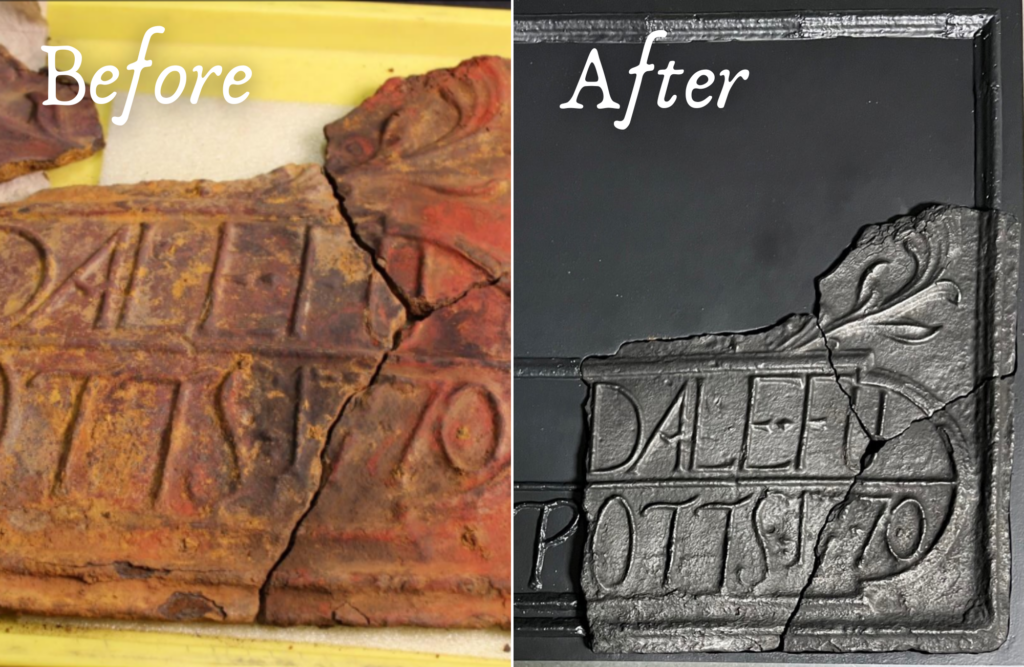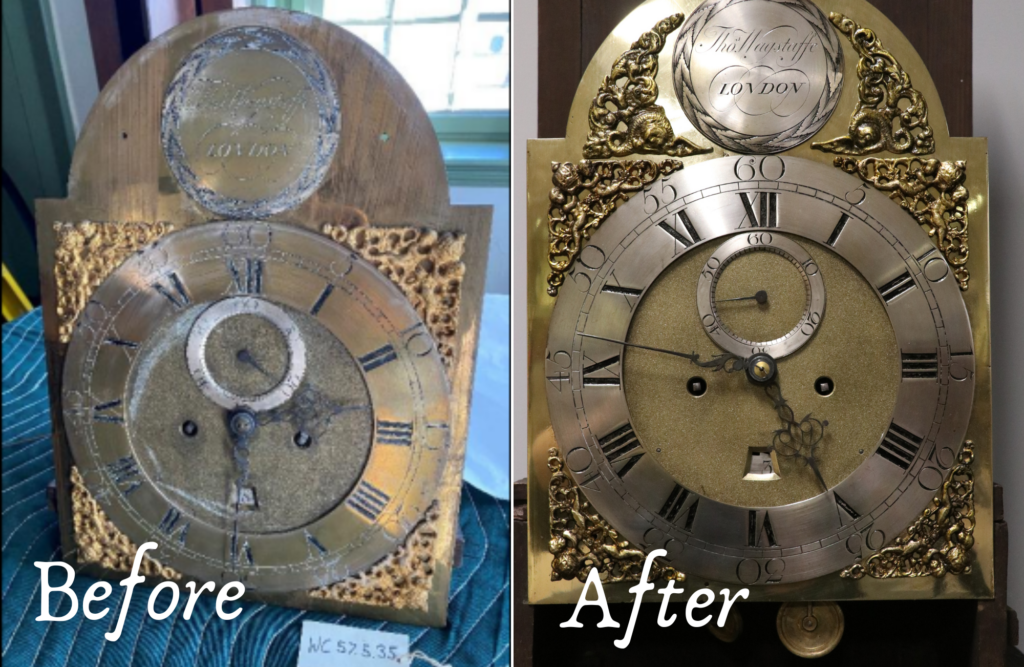Two pieces of American history were recently restored, and both will soon be displayed at the park. One of the objects was unearthed in the 1970s and has never been seen by the public. The other is a treasure that has been hiding in plain sight for decades.
The conservation of both objects is important to the park’s ability to tell the story of daily life in Bucks County during the Colonial era. These restorations were made possible thanks to generous grants from the Americana Corner and the sponsorship of the Washington Crossing Chapter, National Society Daughters of the American Revolution.
The Stove Plate

In 1977, fragments from a 1770 iron stove plate were unearthed during an archaeological excavation at the Thompson-Neely Mill site(s). The fragments have been stored in Harrisburg since then and never displayed. Aside from the house itself, this is the only documented object from the Thompson-Neely property that was present at the time of the 1776 encampment of the Continental Army.
“We believe the stove plate was there in 1776 because Robert Thompson’s will lists a 10-plate stove as part of his possessions at the mill,” says Kim McCarty, curator at Washington Crossing Historic Park. “Robert died in 1804 and one of the stove plate fragments we recovered has the year 1770 on it.”
“We believe the stove was manufactured by the Colebrookdale Furnace in Berks County, which was run by Thomas Rutter and Samuel Potts in the 1770s,” she continues. “A fragment of the plate has the letters ‘otts’ on it so we can surmise that it once said ‘Potts.’”
A 10-plate stove is just what it sounds like – an iron stove made up of 10 separate metal plates of varying sizes. The fragments unearthed at the park were likely from exterior plates, either on the right or left side of the stove.
During conservation, the stove plate fragments were cleaned of surface corrosion and later degreased and cleaned using lint-free cloths saturated with acetone. The fragments were eventually given a protective coating of stove black or stove polish.
“In order to display the fragments, a mount was designed to hold them in their proper orientation to allow for exhibition,” McCarty says. “Dimensions were held to the measurements of the original plate, and a ‘P’ was made on the mount to improve the visitor experience.”
“We believe this is rare piece because we couldn’t find any examples of plates from that furnace that had a design similar to ours,” she adds. “We left about half of the mount blank because we couldn’t be sure what the design was on the rest of the plate because there is no other example for us to examine.”
The stove plate will be displayed in the near future in the park’s visitor center museum.
The Tall Case Clock

For decades, an 18th century clock (circa 1776) has been on display in the McConkey Ferry Inn. An exemplary piece of craftsmanship from the Revolutionary War era, the clock was made by London clockmaker Thomas Wagstaffe.
“Many Philadelphia Quaker families had Wagstaffe clocks in their homes,” McCarty says. “As far as we know he was strictly a clockmaker, so a cabinet maker likely built the case it sits in.”
“The case has been altered, but probably 200 years ago,” she continues. “The bonnet – the top part of the cabinet that surrounds the actual clock – used to be taller. And there may have been finials or another decorative element at the top that were removed at some point. Maybe they broke off or maybe the clock needed to fit in a smaller space.”
During the conservation process, the clock bonnet was partially disassembled to make necessary repairs, and damaged hinges used to secure the bonnet door were repaired. The dial and its components were removed for treatment, which included removing the old polish residue and deteriorated lacquer. The brass back plate was lightly polished to remove the uneven tarnishing and streaking caused by the earlier deteriorated lacquer coating.
The hour and day chapter rings were cleaned and locally re-silvered as original. The black pigment found in engraved numerals and decorative engraving was strengthened using a black pigmented microcrystalline wax. All brass and re-silvered components were degreased and given a spray application of a synthetic, reversible lacquer coating to slow or prevent tarnishing.
“In addition, replacement spandrels were researched and secured to replace the two that were missing,” McCarty says. “The clock case was cleaned using mineral spirits and then wax polished. After the clock was reassembled, it was wound and is once again able to keep time.”
The conservation of both the stove plate and clock was expertly done by B.R. Howard & Associates, a professional conservation and restoration company in Carlisle, PA.

